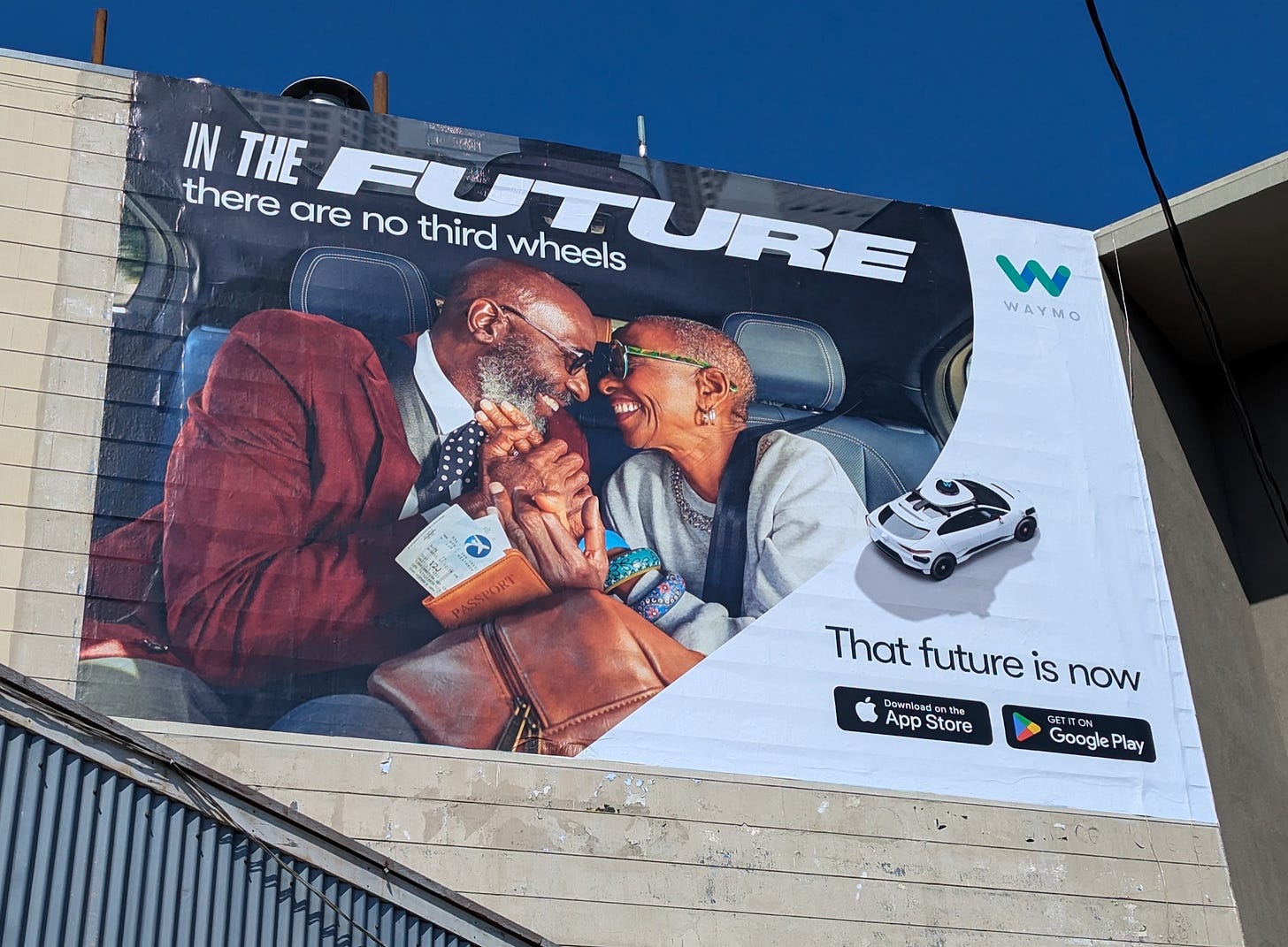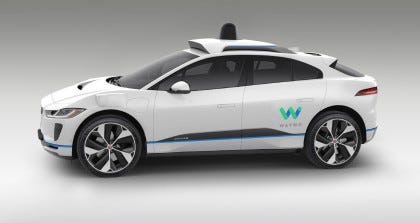The romance of the robotaxi
A Waymo outdoor ad puts the emphasis on canoodling, not technology.
According to Google, which ought to know, there are currently 300 Waymo autonomous vehicles cruising the streets of San Francisco, although on some days it seems like there are closer to 3,000. The driverless white SUVs, which can be summoned via an app, are the product of Google’s parent company, Alphabet.1 And a new outdoor ad wants you to know that a trip in one of those robotaxis isn’t just “convenient, consistent, and safe,” as the website puts it: it’s sexy.

There’s a lot more to that ad than meets the eye. Let’s unpack it, shall we?
The San Francisco Waymo fleet is made up of Jaguar I-PACE crossover SUVs. That may sound sporty and elegant, but if your idea of a Jaguar is a sleek E-type, think again.

The protruding, spinning thingy on the roof contains a variety of sensors. What Waymo will do when Jaguar discontinues the I-PACE in 2025, as previously announced, is TBD.
Driverless cars — not just Waymo’s Jaguars but also General Motors–backed Cruise’s Chevy Bolts and Nissan Leafs — have been tootling around San Francisco’s 49 square miles since 2022. Waymo has operated in Arizona even longer: In June 2021 Malcolm Gladwell gushed on his Revisionist History podcast about his Waymo ride in Chandler, Arizona (“a completely Zen experience”); by the end of the episode Gladwell was referring to his Waymo car — a Chrysler Pacifica, not a Jaguar — as “he.” “I love you, Waymo” was the episode’s title. Waymo also operates in parts of Los Angeles, and will soon launch in Austin, Texas.
In San Francisco, the road to full vehicle autonomy has been pocked with potholes, perhaps to be expected in a city of 800,000+ (compared to Chandler’s 280,000) and a population density of 18,633 per square mile (4,276 in Chandler). Cruise was forced to suspend operations altogether in October 2023 after a series of incidents that included a pedestrian being dragged 20 feet. (Cruise vehicles returned to public roads in May 2024.) Just this week, Waymo was in the news after residents of San Francisco’s South of Market neighborhood reported “being awakened throughout the night by Waymo self-driving cars honking at each other in a parking lot. No one is inside the cars, and they appear to be automatically reacting to each other's presence.”
In general, though, the case for autonomous cars rests on safety: A robotaxi is never drunk or distracted, and its sensors are far more sophisticated than your mere human eyes and ears. I personally have marveled at a driverless Waymo politely yielding to my Honda Clarity at a busy downtown San Francisco intersection. Most human-piloted cars would have ignored me, or worse.
The outdoor ad I photographed swerves in a different direction. It’s saying that you and your sweetie can hitch a ride to the airport — the Phoenix airport, anyway; SFO hasn’t yet been approved — without anyone in the driver’s seat to pry into your business. No “third wheel,” that is.
I had to wonder: where did that “third wheel” expression come from? Cars have four wheels, usually. If it’s extra, shouldn’t it be fifth wheel?
It turns out that both “third wheel” and “fifth wheel” are commonly used and convey the same meaning: a superfluous, unwanted person. According to one not-entirely-authoritative source2 I consulted, “third wheel” originated in the U.S. in the mid-19th century. Why? Unexplained. (“Fifth wheel” is more logical: an extra wheel on a four-wheel carriage.)
Ready for a digression? Here’s something I learned while researching “third wheel”: In the UK, the equivalent expression is apt to be “play gooseberry.” Phrase Finder, a UK reference, tells this story:
When ‘play gooseberry’ was coined, in 19th century England, it referred to someone acting as a chaperone to a couple. It was widely accepted in middle class circles that it would be improper for a woman of good character to be alone with a man of marriageable age. More recently the expression has come to refer to anyone who is present as a third party to a couple who would rather be alone, whether deliberately or not – more like the US ‘third wheel’.
So, why gooseberry?
The expression alludes to the role of the chaperone, who had to be present and within earshot of the romantic couple but had also to pretend to be otherwise occupied. If this scene was played out inside a home the pretext might be sewing or reading a book; if outside it might be picking flowers or fruit. ‘Playing gooseberry’ began as ‘playing gooseberry picker’.
All very charming and pastoral, but Green’s Dictionary of Slang tells a different tale. A gooseberry, says GDoS, can be a fool or a foolish statement; some laundry hanging on a clothesline; or (U.S.) “a small piece of excrement hanging around the anus.” (You’re welcome.) GDoS does have an entry for gooseberry = someone who will not leave a couple to themselves, but says its origin is Australian, circa 1895.
End of digression.
The North Beach outdoor ad remains the only one I’ve seen for Waymo. I haven’t been able to figure out which agency created it, and I don’t know whether it represents a trial balloon or a commitment to a new branding message aimed not at 20-something tech workers but at sentimental 50-something couples. If the latter, Waymo may be betting that at least in San Francisco we’re so used to ghostly cars whooshing around the city that we don’t need to be told they’re safe. We’re ready to hear that they represent a return to cars’ original purpose: as private snogging dens. But beware: at least one of those high-end sensors is watching your every move.
The service was originally called the Google Self-Driving Car Project.
The usual reliable sources — Merriam-Webster, OED, Green’s Dictionary of Slang — are all mum on the subject of third wheels.




As a British reader I am wowed by exotic tales of Robotaxis and heartwarmed to read Play Gooseberry" and "Snogging" from an American writer.... Well done.
Kevin
I’m still trying to get past one of the gooseberry definitions… 💩